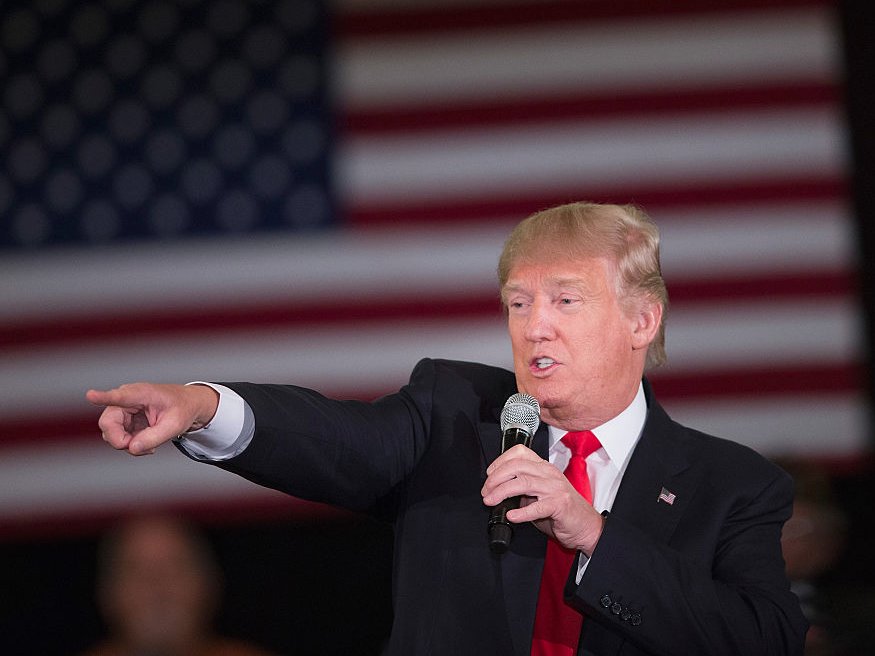 Donald Trump.Scott Olson/Getty Images
Donald Trump.Scott Olson/Getty Images
The White House began its roll out of its fiscal year 2018 budget on Monday, setting the stage for a battle over proposed massive cuts to domestic programs at the expense of increased defense spending.
While the full budget will be released and distributed to Capitol Hill lawmakers on Tuesday, Office of Management and Budget director Mick Mulvaney shone a light on some of the details during a call with reporters on Monday.
The budget, officially dubbed “A New Foundation for American Greatness,” includes massive cuts over the next ten years to social safety net programs like Medicaid, food stamps, and the Children’s Health Insurance Program (CHIP) while increasing the budget for the Department of Homeland Security and Department of Defense. According to Bloomberg’s Justin Sink and Erin Wasson, the budget would cut domestic agencies’ budgets by 40% in 2027.
The plan is expected to receive pushback not only from incensed Democrats, but likely many Republicans. Additionally, cuts to farm subsidies and student loan programs will also face pushback from strong interest groups.
While the bipartisan resistance to the budgetary ideas will be huge, the White House’s attempt does represent the first bid in a long process to funding the government.
Here’s a breakdown of some of the key points from Mulvaney’s briefing on Monday:
- An assumption of 3% economic growth: Part of the Trump team’s assumptions in paying for plans from the budget to their massive tax cuts has been a system called dynamic scoring, which factors in an assumption of stronger economic growth for increased payments to the government. The White House budget proposal, said Mulvaney, is “part of an effort to get to sustained 3% economic growth.” GDP growth in the first quarter of 2017 was 0.7% annualized according to the Bureau of Economic Analysis.
- Massive cuts to Medicaid: The budget proposes an additional $610 billion cut to Medicaid, with $250 billion in savings to offset it. Based on Mulvaney’s comments, it appears this is in addition to the $880 billion already cut under the House’s American Health Care Act. “We go another half a step further [beyond the AHCA] and ratchet down some of the growth rates that are assumed in the AHCA,” Mulvaney said. “So if you assume growth rates — I can’t remember what the exact measure is — it’s a CPI-plus measure. We take a measure that we think is closer to what the actual growth rates look like.
- Large cuts to foods stamps, officially known as the Supplemental Nutrition Assistance Program (SNAP) According to Bloomberg, the cuts to the food stamp program in the budget would amount to $193 billion. The program would also phase in a work requirement, according to Mulvaney, so that people without dependents would have to be employed to qualify.
- Changes to federal student loan repayment: The budget would not only call for overall cuts in federal spending on education, but also reshape how people pay back federal student loans according to Bloomberg, allowing debtors to pay up to 12.5% of their discretionary income towards loans, up from 10%.
- Cuts to federal employee retirement programs and disability benefits: The budget will call for a $72 billion cut over ten years to the Social security Disability Insurance. According to Mulvaney, this will inspire more people to get off disability and back to work.
“If the folks who are on Social Security disability insurance who are not supposed to be, if they go back to work, they’re paying into the system, and they’re not taking out of the system,” Mulvaney told reporters. “So it does make the programs healthier.”
- $1.6 billion for border-wall funding: “The spending on the border security is $2.6 billion, of which I think $1.6 billion is actual bricks and mortar construction,” Mulvaney told reporters. “The other $1 billion is infrastructure and technology.”
- Increased funding for childcare credits and family leave: A projected supported by Trump’s daughter Ivanka and touted during the campaign, the program would create $25 billion over 10 years in spending for the paid family leave. Mulvaney said the parental leave program will help get the country to 3% sustained economic growth.
“We need men and women who are sitting home thinking you know what, I don’t know if I can go back to work because we’re getting ready to have a kid,” Mulvaney said. “And what happens if I have to stay home? We try and create the environment where people are more comfortable going back to work and staying at work knowing that if they do have a child, they’ll be able to spend time with that child under the paid parental leave program.”
The budget does not include any cuts on the topline to Social Security or Medicare. Trump promised during the campaign to not tough those two entitlement programs and Medicaid, but has reversed course only on the low-income health coverage program.
Mulvaney will testify on Capitol Hill in the House on Wednesday and speak to the Senate on Thursday.
A budget is needed by the end of September to prevent a government shutdown.
More from Bob Bryan:
NOW WATCH: Watch Hasan Minhaj roast Trump at the White House correspondents’ dinner













